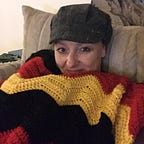This Is a Rule You Must Remember: 20–20–20
A while back my boyfriend and I walked into our favorite taproom. I had a very productive day writing, so I felt I deserved some “Miller Time.”
We moved toward the bar to see what was on tap. I looked up at the menu board, and the words were blurry. I adjusted my glasses, blinked several times, and looked again. Still blurry.
I freaked out. I was upset. I said something to my boyfriend, almost as a cry for help.
Showing genuine concern, he calmly suggested that it was probably because I was staring at my laptop all day. He then asked me if I took any screen breaks. I had to admit that I didn’t remember taking that many.
There’s a lot of talk about screen time and how it affects vision health. I’ve always had a desk job with a computer. But as a freelancer, I spend much more time looking at a screen than I ever did before. My change in livelihood, while making me happier, has taken a toll on my eyes.
Thankfully, I know about the 20–20–20 rule.
What Is the 20–20–20 Rule?
If you regularly see an eye doctor, perhaps they’ve talked with you about screen time during one of your visits. In my case, an ergonomist at my previous job told me about 20–20–20. The rule is simply this:
· After every 20 minutes of using a screen,
· look at something 20 feet away
· for 20 seconds.
Computer eye strain is a thing. The experts call it computer vision syndrome (CVS) or digital eye strain. Most of us blink about 15 times every minute. However, when we stare at a screen, our blinking drops to 5–10 times per minute. Infrequent blinking means our eyes don’t produce enough of the lubrication that prevents eye strain.
Is CVS irreversible? Well, there’s no concrete evidence that smartphones, computer screens, or other such digital devices will permanently damage your eyesight. However, CVS still sucks. You’re likely to have it if your eyes are tired, sore, burning, or itching (unless it’s allergies!). Other symptoms include:
- Dry or watery eyes
- Doubled or blurred vision
- Headaches
- Light sensitivity
- Difficulty keeping your eyes open
- Soreness in your neck, shoulders, or back
Research suggests that taking screen breaks can reduce CVS. In a study examining eye strain among college students, two continuous hours of computer use caused CVS symptoms in about 90 percent of the individuals surveyed. The results suggest that taking periodic pauses to look at things at a distance reduces eye strain significantly.
I’m convinced that the 20–20–20 rule works. If taking screen breaks isn’t something you’ve seriously considered, now is a good time to try. It’s easy to do. Over a short time, it’ll eventually become a habit.
Every 20 Minutes
I often get hyper-focused when I’m in the middle of writing. It’s easy for me to let those minutes whiz by. If I don’t set the alarm for a break, two, three, four hours go by. When I try to readjust my eyes, it’s like I’m peering through Vaseline-smeared glasses.
I use the Pomodoro method, and my breaks are 25 minutes apart. It’s not 20, but slightly less frequent breaks are better than nothing. If you like using apps, try Eye Care 20 20 20, LUMES 20–20–20, or Breaks For Eyes. A simple kitchen timer also does the trick.
Look at Something 20 Feet Away
Why 20 feet? That’s the distance at which most people’s eyes can unwind and use virtually zero effort. The key is to relax the eyes.
It can be hard to figure out what 20 feet looks like. It doesn’t have to be exact. Just focus on something far away, like a tree outside your window. If that’s not possible, consider taking a walk outside so that your eyes have a larger area in which to adjust.
Hold Your Gaze For 20 Seconds
Don’t cheat yourself on the time. Twenty seconds does matter; that’s how long it takes for your eyes to relax and adjust completely. If the wait seems too torturous, get up and walk around. Brew a cup of green tea; it has catechins, which are antioxidants that help your eyes produce tears.
One More Thing . . .
Despite my best efforts, I don’t always remember to apply the 20–20–20 rule. Nevertheless, what’s important is to pull ourselves from our screens occasionally. Any break is better than none.
Besides, I hate ordering the wrong beer when I can’t see the menu at the taproom.
